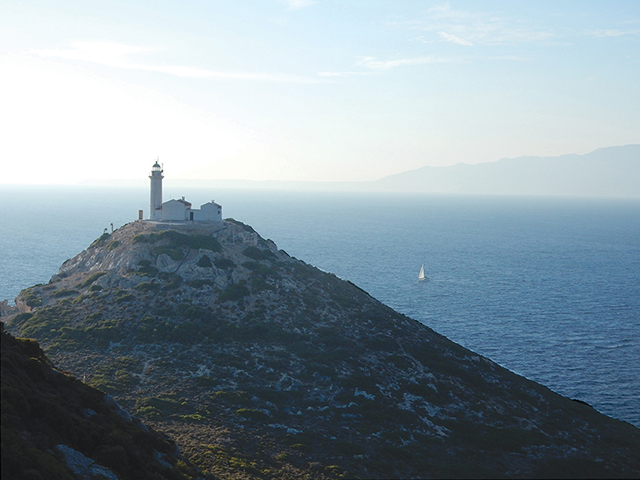Exploring one of the Mediterranean’s finest destinations by land and sea (published January 2015)
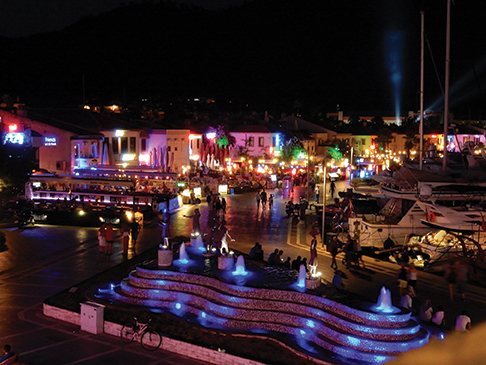
Turkey in August is the beginning of the fall sailing season. It is hot and dry during the day and the projects aboard Celador, a Beneteau 41.1, had to be done early to avoid the heat. Fortunately, the sparkling pool at Marmaris Yacht Marina was the place to cool off in the afternoons. In the evening we walked through the souk in the old town, admiring lovely carpets, ceramics and cobalt glass “evil eye” talismans. Families strolled on the quayside where the gulets dock. And the music of the town went quiet when the muezzin made the evening call to prayer—timeless, evocative and exotic.
Our plan was to cruise along the scalloped coast of Turkey. The mountainous coastline is deep and steep, and dock space is limited, so med mooring is a must. There are scores of protected coves, but we mostly moored in towns where we could explore Turkish culture.
TURKISH DELIGHTS
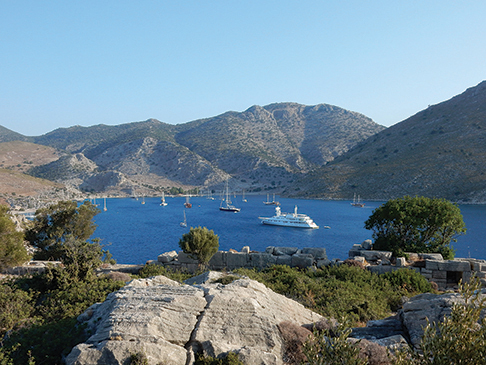
After leaving Marmaris, our first stop was Buzuk Kale, a remote cove invisible but for the Turkish flag flying from the headland, which is a common day mark indicating the presence of a harbor. Ali Baba’s restaurant perches on log pilings over the water and offers free docking to guests. There’s a traditional domed wood-fired oven out back that never cools down. After tying up, we dined on incredible lamb kebab, honey sweet figs and crusty, chewy bread perfumed with wood smoke. In the cool early morning we climbed up to the massive Ottoman-era fort that afforded great views of the harbor and sea.
Sailing south and east with fair, light winds, we anchored in Gocek on sandy bottom off a long beach. I was frying some fresh bonito we’d caught when we heard a boat approaching. “Would you like to take a trip to see the tombs, the ancient city of Kaunos, the turtle beach and the mud baths?”
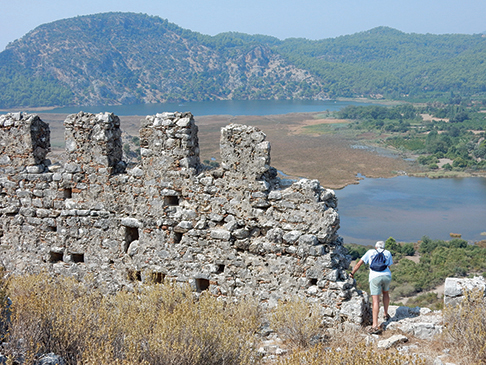
We negotiated the price of 100 Euro for a half-day tour. The tourist boat, run by father and son and belonging to an organized cooperative for the benefit of visitors and tour operators alike, came promptly at 9 a.m. From Celador we motored east, passing nearby sea caves and piney hills. I could smell fresh water as we approached the river delta.
Slipping behind the sandbar, we were suddenly in a sea of grass with a fairway winding through it. On we went to Kaunos, a prosperous city built before the 6th century B.C., situated near Dalyan. The city was a great seaport in antiquity, but river silting caused it to fill. The ruined city has an agora, baths and an amphitheater.
The battlements of the citadel stood intriguingly stark against the sky, so we decided to climb to it. We scrambled up and over rough, trackless limestone crags and once atop the walls there were sweeping panoramas of farm fields and orchards, and the river winding to the sea through fish corrals as in ancient days.
To get back to the boat we picked our way down, drenched with sweat and tried not to slip and tumble over the rocks. From there we continued upstream to the Carian cliff tombs—majestic timeworn structures carved from the living stone. A short distance farther upstream we docked in Dalyan, a delightful place with a beach town vibe. In a café along the quay we refreshed ourselves with rich, freshly pressed pomegranate juice.
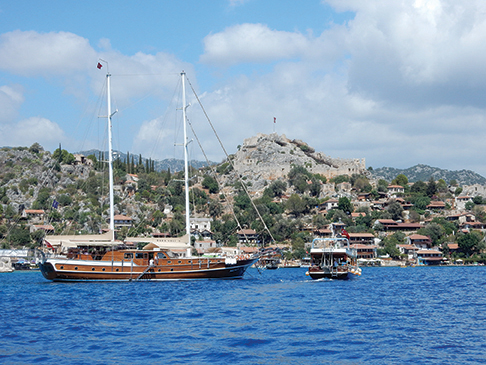
Underway again, we motored farther east toward Kas as the meltemi winds had gone quiet. We docked in the new and luxurious Kas Marina, which at 45 Euro per day included water and power. On the short walk into town we passed Lycian saddleback tombs being used as planters, perched improbably in parking lots and boatyards. The town was pleasant and shady, with clean streets and shops open and welcoming.
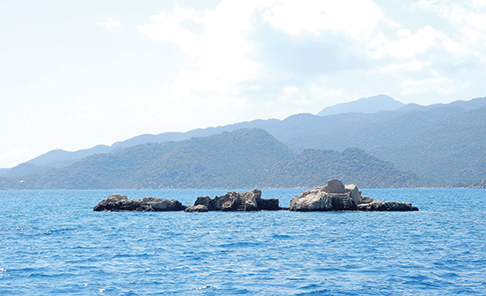
We came into the old town—a Cultural Heritage site—with its paved squares, flowering trees and cobbled streets graciously lined with cafés and little shops selling cotton gauze clothes, evil eyes, hand made soft leather genie hoes and bulk spices. I bought a bag of mint so we could make our own yogurt dip and some frankincense. Walking up the main street, we toured a carpet store with an owner who obviously adores his work. Over tulip glasses of apple tea, we learned about the traditional patterns, dyes and uses of the carpets we were shown.
I admired them all.
Walking on, we found the pedestal-base of the King’s tomb with weathered lions carved on the beam ends. We decided to remain in the coolness of the town and stopped for Turkish coffee and apple tea at a café where we stayed for a lunch of kebab and grilled whole sea bass with luscious seasonal tomatoes. English and Russian day-trippers meandered by while Turkish moms wearing headscarves and long tunics pushed strollers with two little boys playfully jostling.
Not able to pass up a cruiser’s favorite, we stopped at an ice cream stand selling unique flavors such as mulberry, pomegranate and pistachio. And vendors of raw almonds displayed their tender wares on a block of ice, offering samples to entice us. It was certainly a colorful day ashore.
Our next stop was at Kekova to see the sunken ruins and we were able to dock at Hassan Deniz Restaurant. Hassan’s mom and the girls waved us in and assisted us with our dock lines. Above Hassan’s is a large ruined castle, which we didn’t have time to explore. Instead, we enjoyed a beverage and mezes, an appetizer tray with pepper dip, tzatziki dip, black-eyed peas in sauce and tomatoes, and enjoyed the view of the sunken city shaded by red hibiscus plants. As we ate we watched a parade of gulets cruise past, circling the bay to view the ruins.
After our delicious meal, we got Celador underway and joined the parade. The ruins are carved from the living stone and fronted with blockscut from native rock. Most of the walls have tumbled, leaving only a few
arches or windows intact. But the scene is still captivating, as you can see submerged foundation walls at the water’s edge.
Content with our visit, we motored west into a little bay near Ucagiz that was shallow enough to anchor. The water was murky with silt, but clean. Nightfall was clear, still and silent but for occasional voices from the few other yachts, cicadas, roosters and the call to prayer.
HAPPY BIRTHDAY TO ME!
With a light breeze, we motorsailed back west again to moor overnight amid the pine covered hills of Gemiler. From here we sailed on to Knidos, an ancient city situated on a peninsula crowned with a stately lighthouse that marks the division between the Aegean Sea and the Mediterranean. We moored at the only dock there for 50 Turkish Lira, about $25 USD, and decided to tour the ruins that are now a park. We walked around for about an hour, viewing the temple of Apollo and the amphitheater. Later, at the only and overpriced restaurant, we dined on grouper kebabs.
That night, I looked at the day’s photos on the computer, read and then fell asleep. Around midnight I was awoken by our German neighbors laughing and having fun, others singing in French, and then someone started to play a saxophone, and very skillfully, too. They played Over the Rainbow, Summertime, As Time Goes By, and ended with Happy Birthday. It was a joyful way to start my birthday, which was the next day, as I felt like it was played just for me.
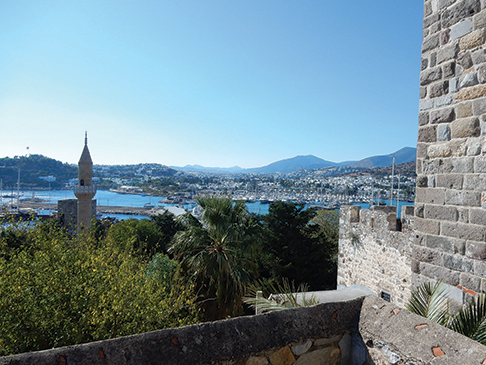
We sailed with fresh breezes to Bodrum, with its Crusader castle. It was an expensive 85 Euro per day to stay in the thoroughly modern Bodrum Marina, with ala carte costs for electric, water and Wi-Fi. Nights in Bodrum were unbelievably loud, with techno music echoing through the marina from the nearby discos. The next day we walked the town and bazaar, shaded with vines growing over lattices built over the street. We headed up to the Castle of St. Peter and walked all through it, viewing shipwreck reconstructions, the cargo of blown glass, Ottoman armor, the Carian Princess’ spectacular golden crown and grave goods. The view from the battlements was spectacular, with a huge Turkish flag snapping proudly.
Motoring back toward Marmaris, we stopped at beautiful Ciftlik Bay, tying up at the dock belonging to Mehmet Place. We hiked up the road for about three miles through a deep canyon with high grey limestone cliffs pocked with caves and through piney woods with beehives nestled among the trees. The views were lovely and we shared lots of laughter. On the way back we stopped at a tiny household café where the lady (who was sleeping in her hammock when we got there) seated us under her grape arbor, then served us delicious chewy flatbread quesadillas filled with spinach, onions and feta, and tulip glasses of hot tea. She gave us bags of herbs and a jar of honey to take back to the boat.
PRACTICALITIES
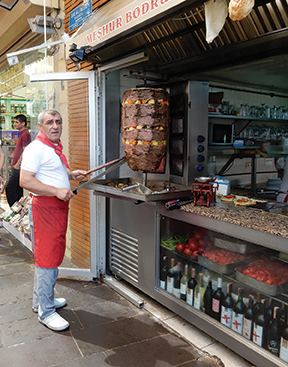 Sailing along the Turkish coast was a delight to me because I had no preconceptions. The towns and cities were very safe and clean. Every bathroom I entered was meticulously clean, too. We never once closed and locked up the boat, as theft is pretty much unheard of where we sailed. The food is fresh, seasonal and locally grown. And the people, though not effusive, were generally quite courteous. A slight tilt of the head may serve instead of a smile, but the acknowledgements were sincere. Freshwater is clean and abundant—in spite of the fact that it only rained once in the six weeks we cruised there, and had not rained for a few more weeks prior to our arrival.
Sailing along the Turkish coast was a delight to me because I had no preconceptions. The towns and cities were very safe and clean. Every bathroom I entered was meticulously clean, too. We never once closed and locked up the boat, as theft is pretty much unheard of where we sailed. The food is fresh, seasonal and locally grown. And the people, though not effusive, were generally quite courteous. A slight tilt of the head may serve instead of a smile, but the acknowledgements were sincere. Freshwater is clean and abundant—in spite of the fact that it only rained once in the six weeks we cruised there, and had not rained for a few more weeks prior to our arrival.
Med mooring is universal here, and anchoring out is not an option in most harbors. As a result, the dinghy culture where you meet and socialize with other sailors at the dinghy dock does not exist here, and it’s harder to meet other cruisers. In addition, the majority of vessels you meet are charter vessels. Boats flying an American flag (and often from Wilmington) are likely to be owned and crewed by Turks or Russians. The majority of sailors we met were German, Russian or Turkish, with occasional Brits or Frenchman. Canadians and Americans are uncommon; making this a great undiscovered cruising ground for us New World sailors. Charter companies are widespread and well run, and many of our familiar charter companies have bases here.
To get a marina slip in Turkey, you must present your boat’s documents, insurance papers, transit log and usually pay in cash.
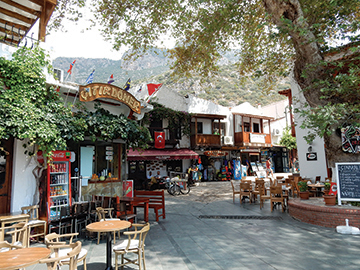
Cruising the Turkish coast was a delight, and there was so much more to see. North of Bodrum lies Ephesus with it’s spectacular marble ruins. South of Kas are wonderful coastal hiking trails. Nearby are the Greek islands of Rhodes and the Dodecanese. It would take months to explore it fully. Inland trips include the cone shaped stone dwellings of Cappadocia and the snowy travertine waterfalls near Pamukkale, and other spectacular destinations that can be visited by bus or cab from nearby harbors. In sum, the coast of Turkey offers exotic and safe destinations with world-class yacht services.
Diane Gorch gets her sea time in by joining yachts that are seeking competent crew. In 2014 she crewed for 6.5 months on the ICW, in the B.V.I., the Mediterranean and western Caribbean. When not sailing, she resides in Cocoa Beach, FL.















